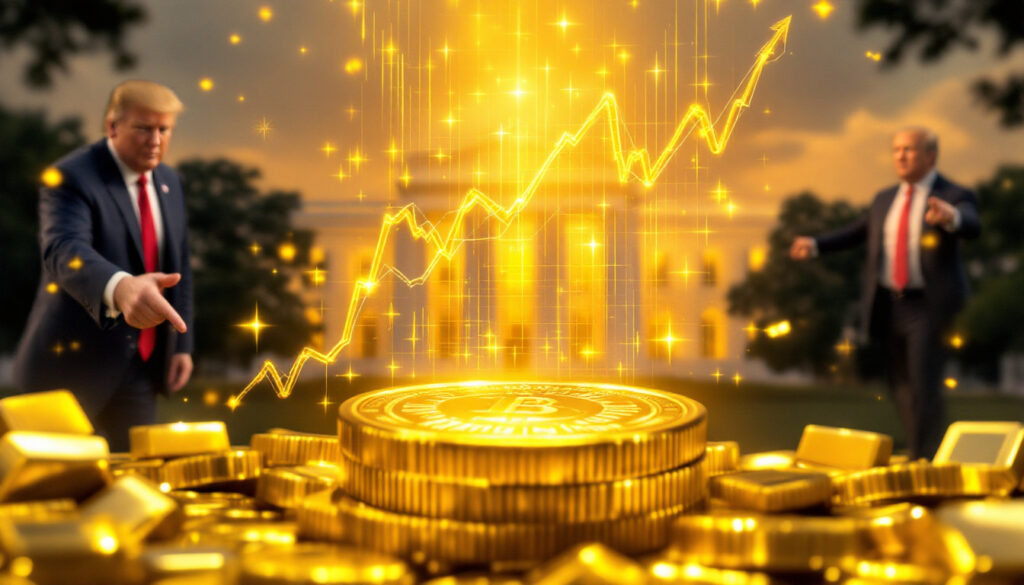Gold Surges to Record Highs as Trump-Powell Tensions Escalate
Gold prices have surged to unprecedented levels, reaching an all-time high of $3,444 per ounce in early Asian trading, driven by escalating tensions between former U.S. President Donald Trump and Federal Reserve Chair Jerome Powell. This rally follows a 2.9% price surge on Monday, reflecting heightened market anxiety over potential political interference in monetary policy. The U.S. dollar has concurrently slumped to its lowest level since late 2023, exacerbating capital flight toward safe-haven assets. Analysts attribute this volatility to Trump's commodity impact and his public demands for immediate interest rate cuts, which have raised concerns about the Fed's independence and long-term economic stability.
What Is Driving Gold's Record-Breaking Rally?
Recent Price Milestones and Movements
Gold's ascent to $3,444 per ounce marks a 14% year-to-date increase, building on a sustained upward trajectory throughout 2025. The metal's 0.6% gain in Asian trading hours underscores its role as a hedge against dollar weakness and equity market turbulence. Notably, this rally contrasts with a 5.3% decline in the S&P 500 index over the same period, highlighting gold as a hedge insights during risk-off sentiment.
Political Pressure on Federal Reserve
President Trump's recent calls for aggressive rate cuts have intensified fears of institutional erosion at the Fed. Historical precedents, such as President Nixon's pressure on Arthur Burns in the 1970s, suggest that political interference often correlates with prolonged inflationary episodes and market instability. Trump's rhetoric, perceived as a threat to Powell's position, has triggered a reevaluation of risk assets, with investors allocating $2.1 billion to gold ETFs performance guide in the past week alone.
How Is Trump's Stance Affecting Financial Markets?
Dollar Weakness
The U.S. Dollar Index (DXY) fell to 94.3, its lowest since November 2023, as Trump's comments eroded confidence in the greenback's stability. A weaker dollar typically enhances gold's attractiveness, as it becomes cheaper for foreign buyers. For instance, Japanese investors saw local gold prices drop by 8% in yen terms due to dollar slumping to a 3-year low.
Broader Market Reactions
Equity markets have faced significant headwinds, with the Nasdaq Composite dropping 7.2% month-to-date amid fears of policy uncertainty. Bond markets have mirrored this volatility, with 10-year Treasury yields swinging 40 basis points since Trump's initial rate-cut demands. This turbulence has accelerated capital rotation into precious metals, with gold trading volumes hitting $210 billion daily—a 300% increase from 2024 averages.
Why Is Gold Considered a Safe Haven During Political Uncertainty?
Historical Performance During Political Crises
Gold's status as a crisis hedge dates to ancient times, but modern precedents are instructive. During the 2008 financial crisis, gold prices rose 25% as equities collapsed, while the 2011 U.S. debt ceiling showdown saw a 34% annual gain. The current crisis echoes these patterns, with gold outperforming tech stocks by 22 percentage points in 2025.
Investor Psychology
Behavioral economists attribute gold's appeal to "disaster myopia," where investors overweigh tail risks during periods of institutional stress. A recent Bank of America survey found 68% of fund managers view gold as undervalued relative to geopolitical risks, compared to 45% in 2024.
What Are the Implications for Central Bank Independence?
Federal Reserve Autonomy Concerns
The Fed's 1951 Accord with the Treasury established its operational independence, but Trump's rhetoric tests this framework. Former Fed Chair Paul Volcker warned that political pressures could undermine inflation-fighting credibility, potentially triggering a 1970s-style wage-price spiral.
Global Central Banking Perspective
The European Central Bank and Bank of Japan have issued rare joint statements affirming central bank autonomy, suggesting coordinated defense of policy independence. Emerging markets, however, face dual pressures—Brazil's central bank governor recently resigned amid similar political demands, sparking a 9% currency crash.
How Might This Affect Gold's Price Outlook?
Technical Analysis and Price Projections
Gold's breach of the $3,400 resistance level opens a technical target of $3,600, according to Citi analysts. The metal's 14-day Relative Strength Index (RSI) of 72 indicates overheating, but divergences in gold stocks performance analysis suggest room for further gains.
Fundamental Factors Supporting Higher Prices
Central banks purchased 1,134 metric tons of gold in 2024—a 45-year high—with China and India accounting for 60% of demand. Inflation expectations, as measured by 5-year TIPS spreads, have risen to 3.1%, enhancing gold's appeal as a real asset.
What Should Investors Consider About Gold Investments Now?
Portfolio Allocation Strategies
Historical analysis shows that a 5-10% gold allocation reduces portfolio volatility by 18% during crises. However, current valuations at 28x trailing earnings for miners suggest selective exposure to physical ETFs may outperform equity-linked instruments.
Timing Considerations
Since 1970, gold has delivered average returns of 9% annually in the three years following all-time highs. However, short-term pullbacks averaging 12% are common, suggesting dollar-cost averaging strategies.
Frequently Asked Questions
What is the historical significance of political interference with the Federal Reserve?
The Fed's independence, formalized in 1951, has been challenged only twice—by Presidents Johnson and Nixon. Both episodes preceded decade-high inflation, with consumer prices rising 7.1% annually under Nixon's pressure.
How does gold typically perform when the US dollar weakens?
A 10% dollar decline historically correlates with a 15% gold appreciation. In 2025, the DXY's 8% drop has amplified gold's rally, particularly in euro terms (+22%).
What other factors beyond political tensions are supporting gold prices?
Central bank demand, particularly from BRICS nations seeking de-dollarization, accounts for 23% of 2025's price gains. Additionally, stagnant real rates (-1.4% in the U.S.) reduce the opportunity cost of holding non-yielding bullion.
This analysis synthesizes gold market analysis, historical patterns, and policy dynamics to explain gold's meteoric rise. While political tensions provide the immediate catalyst, structural shifts in monetary policy and global reserve management suggest sustained relevance for precious metals in institutional portfolios.
Disclaimer: This article contains analysis and forecasts based on current market conditions. Financial markets are inherently unpredictable, and investors should conduct their own research before making investment decisions.
Want to Discover ASX Mining Opportunities Before the Crowd?
Stay ahead of the market with Discovery Alert's proprietary Discovery IQ model that instantly identifies significant mineral discoveries on the ASX, turning complex data into actionable investment insights. Explore historic examples of exceptional returns from major discoveries by visiting the dedicated discoveries page and start your 30-day free trial today.




